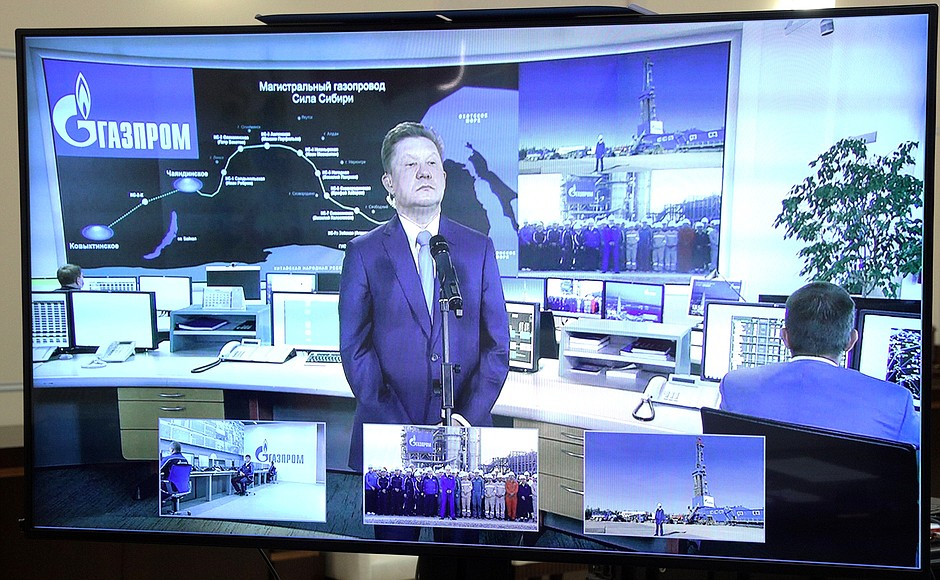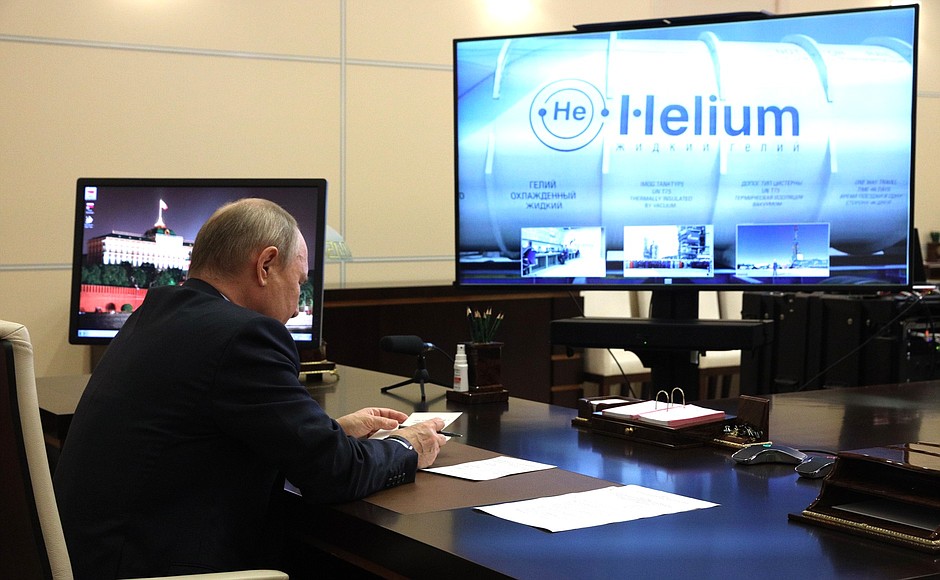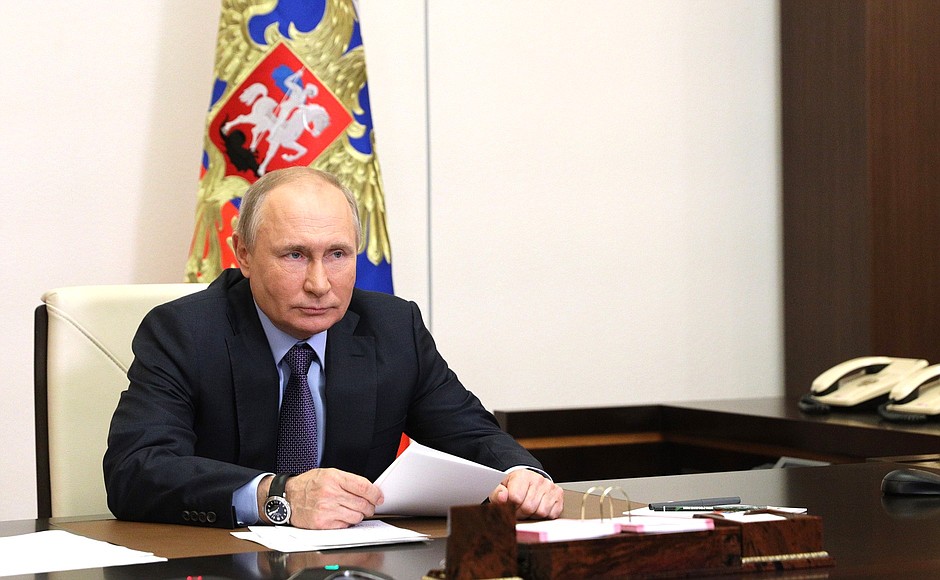The Amur Gas Processing Plant near Svobodny ranks among Gazprom’s major infrastructure projects in Russia’s Far East. Its construction was launched in 2015. The facility will process multi-component natural gas from the Yakutia and Irkutsk gas production centres. The gas will be delivered via the Power of Siberia gas pipeline.
The Amur Gas Processing Plant is to attain design capacity in early 2025 and will annually produce 42 billion cubic metres of gas. Six production lines with an annual capacity of seven billion cubic metres of gas each will be activated stage by stage. The Plant will include the world’s largest helium production facility with an annual capacity of up to 60 million cubic metres.
Gazprom’s processing capabilities will increase by 80 percent after the Amur Gas Processing Plant attains design capacity.
* * *
President of Russia Vladimir Putin: Mr Miller, colleagues, friends,
Good afternoon, I am happy to be greeting you all.
Today, we are witnessing a landmark event: Russia’s Gazprom is launching the first production line of the Amur Gas Processing Plant. After attaining design capacity, it will become one of the world’s largest enterprises for processing natural gas and the largest producer of helium, a gas in high demand at numerous key high-tech sectors. Helium is part of medical gas mixtures, artificial air for both divers and cosmonauts; it is also used in magnetic resonance imaging, to make computer chips, optical fibre cables, LCD screens and so forth.
See also
We have been watching this project since its inception because it has special significance for the Russian economy. We launched it in 2015, and, as far as I recall, I visited the construction site in 2017. We constantly monitored its implementation.
I am aware that several thousand specialists from many Russian regions and their foreign counterparts have worked hard to make this project a reality. A number of complicated construction, engineering and logistic tasks have been accomplished. All environmental requirements have been complied with, and unique Russian and foreign-made equipment has been installed.
In this context, I would like to note the weighty contribution made by our foreign partners who were actively involved in equipping the plant. We certainly welcome such cooperation, and we are counting on it in the future.
I would like to sincerely thank all of your large and well-coordinated team for your perseverance, responsibility, for your dedication to achieve the maximum result.
You have created a truly large industrial complex, strategically important, without exaggeration. Again, it is not just significant for the industry, but also for the entire national economy, for the development of Eastern Siberia and the Russian Far East. The Amur Gas Processing Plant is a good step towards increasing the natural gas refinery yield, which means sustainable and efficient use of natural resources.
After reaching full capacity in 2025, the plant will annually process – Mr Miller will correct me if I am mistaken – 42 billion cubic metres of natural gas, and produce about 60 million cubic metres of helium. This will be enough to meet the domestic demand for helium, as well as to take one of the leading positions on the global market.
At present, the United States accounts for 56 percent of the world market, Qatar, for 28 percent, Algeria, nine, while Russia's share is only 3 percent. We will significantly increase our capacity.
I would also like to underscore that the Amur Plant will be part of a large gas chemical cluster, which is now being developed in the region. Sibur is building its flagship polyethylene and polypropylene plant here. The Amur plant will supply raw feed for the Sibur facility.
The launch of such up-to-date production facilities means thousands of new jobs for qualified specialists, an increase in tax revenues, the development of transport infrastructure, more housing, and an entire range of public services – a new outpatient clinic, a kindergarten, a school, and other facilities. All this will improve the quality of life in the region.
We are now adopting far-reaching plans for the development of the country's infrastructure, for the modernisation of industries, for unleashing the potential of all Russian regions, from Kaliningrad to Vladivostok. Your work to build the Amur gas processing plant is definitely direct and visible proof that we are ready and capable of implementing such ambitious plans.
I would like to wish you further success and to congratulate you once again on today's landmark event. All the very best.
Go ahead, please, Mr Miller.
Gazprom Board Chairman Alexei Miller: Mr President,
The Amur Gas Processing Plant will be the anchor enterprise of a new gas deep processing and petrochemical centre in eastern Russia. It will process about 42 billion cubic metres of gas annually. Today, we are launching the first production line.
The construction schedule was extremely rigid; the project required a great amount of work. Today, we can say that we are launching the plant in strict compliance with the officially planned deadlines; it took us less than six years to complete it.
The plant will produce 2.4 million tonnes of ethane, 1.5 million tonnes of liquefied hydrocarbon gases (propane and butane), 200,000 tonnes of pentane-hexane fraction, as well as helium. All valuable components will be removed from the gas at this plant, and residual gas will be pumped back into the Power of Siberia trunk pipeline. Capacity will expand gradually as the plant receives increasingly more gas via the Power of Siberia pipeline.
Helium should be noted separately. This is an important product of the plant that will produce about 60 million cubic metres of helium annually. The plant will become the world’s largest helium producer.
Helium is in high demand at the most advanced production facilities. We are seeing the demand for helium continue to increase, especially in Southeast Asia. A hub for delivering helium to international markets will be completed near Vladivostok soon.
Of course, it also became necessary to create strong infrastructure for this major project. About 30 kilometres of roads were built under the project, and a 40-kilometre railway links the plant to the Trans-Siberian mainline. A pier was also built on the Zeya River.
As the plant is an energy-intensive enterprise, the 160-megawatt Svobodnenskaya thermal power station was built nearby. The station uses Russian-made power-generating equipment.
The social infrastructure for the plant’s workers and their families includes a modern residential district with a general school, an outpatient clinic, a kindergarten, a cultural centre and a sports complex. Within the framework of the Gazprom for Children programme, we have built a comprehensive sports and recreation centre for over 200 people in Blagoveshchensk. Most importantly, the facility has the region’s first gyms for martial arts including boxing, wrestling, judo and karate.
Gas is transported to the Amur Gas Processing Plant from the Chayandinsky field, so I will now give the floor to Mr Dzhalyabov, Director General of Gazprom Dobycha Noyabrsk.
Please.
Director General of Gazprom Dobycha Noyabrsk Anton Dzhalyabov: This is Anton Dzhalyabov, Director General of Gazprom Dobycha Noyabrsk, reporting.
I am at the Chayandinsky field, which is currently being developed and where we are building new production facilities. In particular, last December we launched the facility’s second phase, specifically preliminary gas processing terminals, a helium concentrate membrane separation plant, and a captive power plant.
There are almost 100 active wells. The quality of gas we are feeding into the Power of Siberia main pipeline meets the required parameters.
The helium concentrate membrane separation plant is a unique industrial facility with a two-stage membrane separation system. This is the first time ever that this gas separation technology has been applied on the scale of the Chayandinsky field.
This technology ensures the rational use of a strategic raw material: part of the helium will be transported for processing and marketing to the Amur GPP via Power of Siberia, the unused part of helium in the form of helium concentrate will be pumped into an underground storage facility.
Modern technologies and engineering solutions ensure a reliable supply of multicomponent gas to the Amur GPP. The operations personnel are currently on duty, and the feeding of gas to the main pipeline is proceeding in normal mode.
Alexei Miller: Mr President,
The Amur Gas Processing Plant is the most sophisticated and high-tech production facility. I would like to give the floor to the Director-General, Mr Lebedev.
Pererabotka Blagoveshchensk Director-General Yury Lebedev: This isGazpromPererabotkaBlagoveshchenskDirector-General Yury Lebedev. The technology for removing valuable components from natural gas utilises a cryogenic process. By reducing the temperature of natural gas, it is possible to separate it into fractions through liquefaction and by isolating specific gases from the initial mixture.
You can see the gas separation columns behind me. They are quite large, almost 100 metres tall; the size is determined by the high-precision process for separating the gas. The tallest column is a methane extractor, and the next column is for extracting ethane, and two columns for extracting a nitrogen-helium mix are next to that.
The first production units at the Amur Gas Processing Plant are ready for processing.
Alexei Miller: Mr President,
We control the production processes, including gas production, transportation, storage, processing and distribution, from Gazprom’s central dispatch control office. Today, we are ready to connect the Amur Gas Processing Plant to this unified control centre.
May I ask you to give the order to activate the plant?
Vladimir Putin: You may begin.
Shift Manager of the Amur Gas Processing Plant’s Operational Dispatch Control Department Yevgeny Dyakov: This is Shift Manager Yevgeny Dyakov at the Amur GPP Dispatch Control Department.
The first production line is ready to receive natural gas from the Power of Siberia trunk pipeline. I am opening the valve, and the gas is now entering the plant. The gas-separation units are functioning properly.
Alexei Miller: Mr President,
The Amur Gas Processing Plant has been launched and has become an integral part of Gazprom’s production system.
Vladimir Putin: Dear friends, colleagues,
I would like to congratulate you on this event once again. This is a capital-intensive and science-intensive project worth over a trillion rubles, all told. I am confident that this entire huge enterprise, with an area of over 900 hectares, will be fully operational in 2024–2025, as planned.
It is particularly good to note that we have many partners who are interested in joint work and specific results, including people and companies from Russia, Turkey, China, India, Italy, the Federal Republic of Germany, Croatia, Serbia, Kazakhstan, Uzbekistan and Kyrgyzstan. As far as I know, this is a huge team of approximately 35,000 people.
I am confident that this joint work will benefit us, and that it will also make it possible to establish many other similar facilities and new alliances for achieving common results.
Thank you very much.
Congratulations once again, and I wish you all the best.



